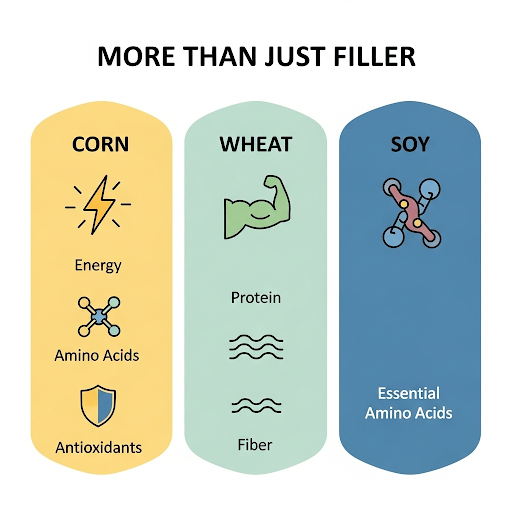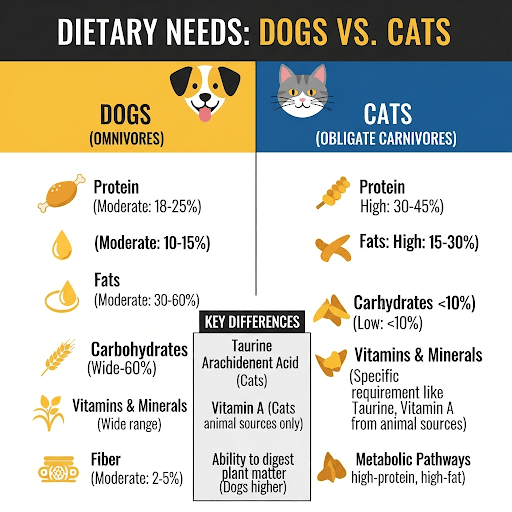Introduction
Walk down any pet food aisle, and you'll be bombarded by bags proudly proclaiming what they don't have: "No Corn! No Wheat! No Soy!" This phrase has become so common that many pet parents now believe it's a gold standard for quality. But as veterinary nutrition experts, we need to set the record straight: the "No Corn, No Wheat, No Soy" myth is one of the most successful marketing ploys in the history of the pet food industry, and it isn't based on nutritional science.
This powerful slogan has created unnecessary fear around perfectly healthy ingredients and has distracted from what truly matters in a pet's diet. Let's separate marketing fiction from nutritional fact.
Where Did This Myth Come From? The Power of Marketing
The "no-no-no" trend didn't originate in a veterinary research lab. It was a brilliant marketing strategy. In the early 2000s, smaller or "boutique" pet food companies needed a way to stand out against the large, established brands that often used corn, wheat, and soy in their formulas.
They tapped into the growing "humanization" of pets and the popularity of low-carb and gluten-free diets for people. By labeling these ingredients as cheap "fillers," they created a narrative that was simple, emotionally resonant, and powerful. They painted a picture of their own foods as being more "natural" or "ancestral," a concept that appeals to every loving pet owner. The strategy worked beautifully, but it created a legacy of misinformation that persists today, making it one of the most pervasive pet nutrition myths.
A Closer Look at the "Big Three": Corn, Wheat, and Soy
When you remove the marketing stigma and look at these ingredients through a scientific lens, a very different picture emerges. They are not villains; they are valuable sources of nutrients when processed correctly.
-
Corn: Far from being an empty filler, corn in dog food is a nutrient-dense ingredient. It provides highly digestible carbohydrates for energy, essential amino acids for building proteins, linoleic acid (an omega-6 fatty acid crucial for skin and coat health), and antioxidants like Vitamin E and beta-carotene. Whole corn or cornmeal is not the same as the corn syrup we associate with junk food.
-
Wheat: For the vast majority of pets, wheat in dog food is an excellent source of energy and provides protein and fiber. A true wheat allergy in dogs is actually very uncommon. While Celiac disease is a serious concern for some humans, it is exceptionally rare in dogs (with a known genetic sensitivity in some Irish Setters). For the average pet, wheat is a perfectly safe and nutritious grain.
-
Soy: Often vilified, soy in pet food is a high-quality, plant-based protein source. It boasts an excellent amino acid profile, is rich in vitamins and minerals, and contains beneficial phytonutrients. It's also a great source of dietary fiber. Like wheat, a true soy allergy is not common in pets.
The idea that these ingredients are inherently "bad" is simply not supported by decades of veterinary nutritional research.
The Real Issues: Ingredient Quality & True Allergens
The focus shouldn't be on avoiding specific ingredients based on myths, but on the overall quality and balance of a diet. What truly matters is that every ingredient, whether it's lamb or corn, is clean, digestible, and part of a complete formula created by experts.
Here's the most crucial point marketing slogans leave out: the most common pet food allergens are not grains. According to overwhelming veterinary evidence, the most frequent culprits behind food allergies in dogs and cats are animal proteins. The top offenders include:
- Beef
- Dairy Products
- Chicken
- Lamb
- Fish (for cats)
Ironically, while consumers were trained to fear grains, the rise of grain-free diets (which often replaced grains with legumes like peas and lentils) became associated with a concerning trend: a potential link to a heart condition called Dilated Cardiomyopathy (DCM) in dogs. This highlights the danger of making drastic dietary changes based on marketing instead of science. (To learn more about identifying true dietary sensitivities, read our guide on [Food Allergy vs. Food Intolerance: What's the Difference?])
Marketing myths about ingredients like corn, wheat, and soy don't align with nutritional science, which shows they are valuable nutrient sources.
Conclusion: Look Past the Slogan, Trust the Science
The "No Corn, No Wheat, No Soy" slogan is a powerful piece of marketing, but it is not a reliable guide to nutritional quality. These ingredients are valuable nutrient sources for the vast majority of pets.
As a discerning pet parent, the best thing you can do is learn to look past the front-of-bag claims. True quality lies in a complete and balanced formula, rigorous quality control, and decades of scientific research—not in the absence of a few demonized ingredients. Instead of avoiding ingredients based on fear, a truly personalized approach considers your pet's unique needs. Our pet meal planner app helps you do just that, focusing on the complete nutritional profile that is scientifically proven to be right for your pet. Always consult with your veterinarian to make the best dietary choice for your furry family member.


